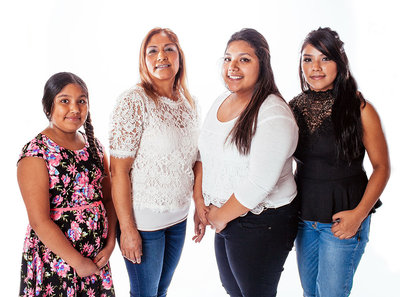
Graduate high school. Think about your future career. Get a profession. That is Leticia Gonzalez’s advice for her daughters. She is sitting with them at the kitchen table in their Springfield home, and they banter with each other about school, work and family.
“Sometimes I think they get tired of listening to me say ‘Go to college,’” Gonzalez says, who requested to speak with EW via an interpreter because she feels more comfortable with Spanish. “It’s the reality: work and study.”
Gonzalez says that in Mexico she never made it past high school. Now, living in Springfield and working as a housekeeper to support her three daughters, she says she hopes a solid education will help her children accomplish their goals.
Like many Latino parents, Gonzalez faces a dilemma: She wants her children to learn English, get good grades and be successful in the U.S., but she doesn’t want them to forget Spanish. As the Latino student population at Springfield School District passes 20 percent this year, schools and families alike are exploring how best to educate bilingual students.
Latinos and Latinas are one of the fastest growing groups in Oregon. As of 2013, Oregon’s population was 12 percent Latino, according to the U.S. Census Bureau, up from 4 percent in 1990. In many school districts, that percentage is much higher than the state average, over 70 percent in some schools around Salem and Portland.
At 20 percent, Springfield School District has the highest percentage of Latino students in Lane County, according to the Oregon Department of Education.
For some Latino families, the immersion in American culture is somewhat of a concern: Their children are learning English a little too well.
That’s one thing Saundra Bautista says she worries about. She has three children in Springfield schools and her oldest daughter is about to graduate from Springfield High School. “Spanish becomes a very small part of their lives,” she says. “All their lives they’ve been listening to English.”
Bautista moved to the U.S. when she was 19. “My English was probably 5 percent,” she says. But she studied in the High School Equivalency Program at the University of Oregon, earned her GED and today works at Guy Lee Elementary in Springfield as a bilingual classroom assistant.
Her children, she says, are having a much different experience than she had. “Sometimes they’re very honest,” she says. “They say they don’t like speaking Spanish.”
The district has a variety of services to accommodate Spanish-speaking families, including El Centro de Bienvenida, a resource center that provides families with a place to find information about schools, interpreting services and low-cost classes. For students who are English language learners, the district has an English language development program in place that offers extra instruction at all levels.
Laura Weiss, the English language development (ELD) specialist for the district, says the services they offer change depending on the trends in the school population. “We want to make sure we’re ready to adapt,” she says. “Our main goal is that we’re providing ELD service.”
Currently, the majority of families are from Mexico, Weiss says, though the district has a growing population of students whose families are from Central American countries like Guatemala and Honduras, as well as families from Vietnam and the Marshall Islands.
Gonzalez says she is proud of her children’s bilingual skills. “They picked up English pretty fast,” she says. “I feel really proud of my daughters, that they are able to speak not only Spanish as a first language but also English.”
One of her daughters, Martha, is a freshman at Springfield High School, a school that is nearly 30 percent Latino. Martha Gonzalez says most of her classmates grew up speaking English like her. “I don’t think I know anyone who just speaks Spanish,” she says.
Phil Carrasco, a Thurston High School graduate, has long been an active member of the Latino community in the area. He says when he attended Thurston in the ’90s, Latino students went largely unnoticed. “There were no student clubs, nothing like that,” he says. But things are changing. “Now there’s a Latino student union,” he says.
He says he hopes to see more involvement from Latinos, especially at the level of the school board. “What does the Springfield School Board look like?” he asks. “Does it look like the students? These are questions to start asking.”
This fall, the district piloted a program that will utilize the unique skills of Latino students: a Spanish-English dual immersion program at Guy Lee Elementary. This year the school is offering dual-language instruction only in kindergarten, but every year a new grade will be added until K-5 instruction is entirely bilingual.
Guy Lee Elementary will be in good company. Woodburn School District, for example, had the state’s highest graduation rate for Latino students in 2014 at an overall rate of 87 percent. The superintendent gives credit, in part, to district-wide dual-language instruction that ensures 95 percent of the students are bilingual, according to a report by The Oregonian.
Bautista says her son is in the bilingual kindergarten class at Guy Lee Elementary. “At the beginning of the year, I was afraid of putting my kid in that program,” she says. But she was surprised to learn that he didn’t know Spanish as well as she thought.
“It’s good for my son learning Spanish because I know he’ll be fluent in Spanish,” she says. “As Latinos it’s important for them to know their language.”